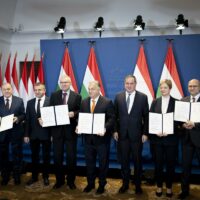Consumption differences between the richer and poorer sections of Hungarian society
Portfolio.hu shared the report of KSH (Central Statistical Office) regarding the households’ consumption in 2015. According to the statistics, by an average household 74,608 HUF were spent on consumption per person every month. This sum was 8.7% higher than the one in 2014. But, there is still a great – approximately threefold – difference between the upmost and lowest fifths’ spending, even though their difference somewhat decreased compared to the numbers of 2014. There are further differences in the country, based on regions and qualifications: it is said that people living in Central-Hungary and those having a higher degree spent far the most.
In 2015 the monthly consumption of households per person was 74,608 HUF. The richest part of the society (upper 20%) spent an average 132,211 HUF per month, while the poorest could afford 43,212 HUF consumption per month. Generally, most of the money (19,885 HUF) was spent on food and non-alcoholic drinks, then people spent second most (16,595 HUF) on the maintenance of their homes and household energy, and the third (8076 HUF) most common spending was on transport.
The report shows that, in every product group, the richest spent at least twice as much as the poorest. Not surprisingly though, the smallest differences occurred in the case of foods (2.1x), alcoholic drinks and tobacco (2.3x), and the home maintenance, household energy (2.5x) consumptions. The biggest differences however, were present in the hospitality industry and education, and when it came to culture and entertainment. In the case of entertainment related spending, the richest spent 7 times more.
Although, it is important to note that the differences between the two extreme income categories had visibly decreased compared to those in 2014. In 2014, wealthier people spent 3.4 times more on consumption than the less wealthy, but in 2015 this rate was 3.1. Also, to the increase of the average consumption mainly the lower income groups contributed. The growth rate in the case of the richest was 6.5%, whereas the bottom fifth spent 18.5% more than they did the year before. As, according to the data of KSH, those in the worst financial situation in the last year spent 6,744 HUF more than in 2014.
In absolute terms the money spent on foods and home maintenance increased the most, while relatively, furnishings, household operations and other products, services gained the biggest increase in consumption. Clothing and educational consuming increased too, but on a smaller base: a poor person, for example, spent 431 HUF more on clothing and 61 HUF more on education per month.
Portfolio writes that the relative consumption growing (6.5%) of the upper section was less, but their absolute (8,065 HUF) growing was far more than the lower’s. But interestingly, they spent less on transport – perhaps because of the lowering of fuel prices – and healthcare. However, the richest 20% spent 2.1 more on foods than the poorest 20%. This meant 28,524 HUF to the 13,861 HUF consumption in 2015.
The product groups showed great differences, on bread and meat the wealthy spent “only” 70% more, but in the case of fruits the difference was 240%, and they spent 380% more money on fish and seafood. Spending more on something, however, did not mean that the bought quantity was bigger. For bread and cereals the richer section spent 70% more money but consumed 18% less. The reasons for this might be the difference in quality, or, in the local price levels.
Differences between the regions’ development and income is also shown by the statistics. Those living in the region of Central-Hungary, including Budapest, spent by far the most money (an average of 90,527 HUF) on consumption. They are followed by the people on the eastern side of the Danube (80,287 HUF) and the western side (77,214 HUF), and the people living on the north of the Alföld spent the least (an average of 61,676 HUF). The distribution of consumption was the same there as well, in the poorer regions people spent more on food and their homes, and less on cultural experiences and the hospitality industry.
The data regarding consumption also shows the distribution based on educational factors. It can be said generally that the higher qualified a person is, the more she consumes, but instead of a cause and effect relationship this is rather based on an indirect relation. They spent an average of 100,768 HUF monthly, which was 70% more than the less qualified people’s consumption (60,989 HUF). The two sections, although, spent barely the same amount on food, alcohol and tobacco. The differences occurred in hospitality, where 4 times more was spent by the ones with higher qualification, and in education, with a 6.3 difference.
Copy editor: bm
Source: portfolio.hu
please make a donation here
Hot news
Nostalgic Advent bus services in Budapest
Hungarian MPs decide on important tax laws
Uniting nations through generosity: the Diplomatic Charity Fair 2024 at Bálna Budapest – Photo gallery, Videos
Hungary ‘safest location’ for East-West cooperation, says Minister Szijjártó in Beijing
Authorities warn about a new form of crime emerging at Budapest Airport
UK-owned DS Smith Packaging Hungary to invest EUR 31m in expansions




